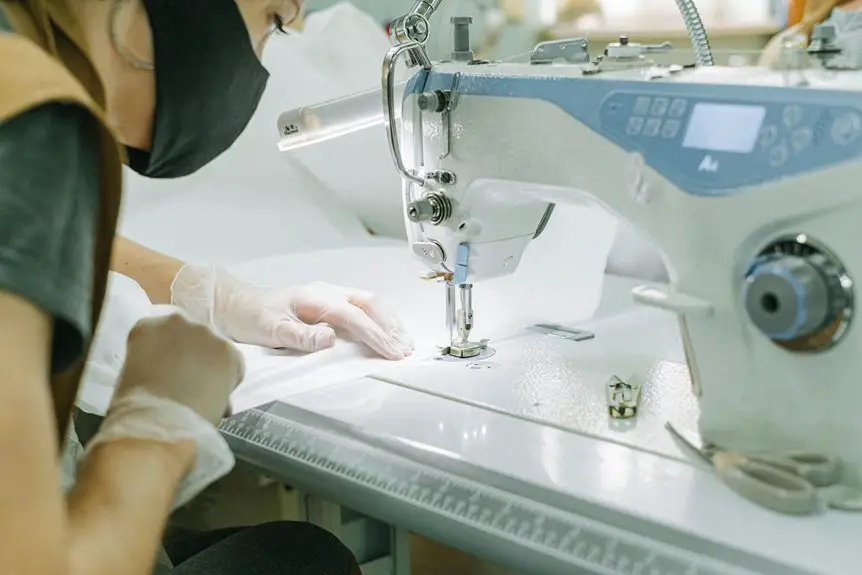You need Kevlar fabric gloves because they provide superior cut and abrasion resistance without sacrificing comfort or dexterity. They protect your hands from sharp tools, heat, and punctures, making them ideal in construction, manufacturing, automotive repair, and emergency response. Lightweight yet incredibly durable, Kevlar gloves keep their shape and resist stretching during demanding tasks. Plus, with advanced designs and easy care, they’re built to last. Keep exploring to discover how Kevlar can elevate your hand protection.
Table of Contents
Key Takeaways
- Kevlar fabric offers superior cut and abrasion resistance, protecting hands from sharp tools and materials in high-risk environments.
- Lightweight synthetic fibers provide durability and heat resistance without sacrificing grip or dexterity.
- Kevlar gloves are widely used in construction, manufacturing, automotive, military, and emergency response industries.
- They meet strict safety standards and certifications, ensuring reliable protection and workplace compliance.
- Proper care, including gentle washing and air drying, extends Kevlar gloves’ lifespan and maintains their protective properties.
What Makes Kevlar Fabric Ideal for Gloves
Because Kevlar fabric combines exceptional strength with lightweight comfort, it’s an ideal choice for gloves that need to protect your hands without restricting movement.
When you wear Kevlar gloves, you benefit from a material that resists cuts and abrasions far better than traditional fabrics. You’ll also appreciate how Kevlar maintains its durability even when exposed to heat, so your gloves won’t easily degrade in tough environments.
Since Kevlar fibers are woven tightly, the gloves fit snugly and allow you to handle tools or materials with precision. Plus, Kevlar’s resistance to stretching means your gloves keep their shape and performance over time.
Kevlar gloves offer a snug fit and lasting shape, enhancing precision and durability during use.
This fabric gives you the confidence to work safely without sacrificing dexterity or comfort.
Key Protective Features of Kevlar Gloves
While working in hazardous conditions, you need gloves that offer more than just basic coverage.
Kevlar gloves provide exceptional cut resistance, protecting your hands from sharp objects and blades. They also offer excellent heat resistance, so you can handle hot materials without worrying about burns.
The lightweight nature of Kevlar guarantees you maintain dexterity and comfort, allowing you to work efficiently without feeling weighed down.
Additionally, Kevlar fibers are highly durable and resistant to abrasion, meaning your gloves last longer even with heavy use. They also resist punctures better than many other materials, giving you added safety against unexpected hazards.
With Kevlar gloves, you get a powerful combination of protection and performance tailored for demanding environments.
Industries That Benefit From Kevlar Hand Protection
When you work in industries where hand safety is critical, Kevlar gloves offer unmatched protection and durability. You’ll find them invaluable in construction, where sharp tools and rough materials pose constant risks.
In manufacturing, Kevlar gloves shield your hands from cuts and abrasions while handling metal and glass. If you’re in automotive repair, these gloves protect you from burns, sharp edges, and chemical exposure.
Even in electrical work, Kevlar’s heat-resistant properties help guard against sparks and minor shocks. For those in law enforcement or military roles, Kevlar gloves provide reliable defense against cuts and punctures during intense situations.
Kevlar gloves offer crucial heat resistance and cut protection for electrical, law enforcement, and military tasks.
Wherever precise, tough hand protection matters, you can count on Kevlar gloves to keep your hands safe and comfortable all day long.
Comparing Kevlar Gloves to Other Protective Materials
Although Kevlar gloves excel in many areas, it’s important to understand how they stack up against other protective materials like leather, nitrile, and Dyneema.
When choosing gloves, consider these differences:
- Leather: Offers durability and abrasion resistance but lacks the cut resistance Kevlar provides. It’s great for general tasks but not ideal for sharp objects.
- Nitrile: Provides excellent chemical resistance and flexibility but doesn’t protect well against cuts or punctures compared to Kevlar.
- Dyneema: Known for superior cut and abrasion resistance, often lighter than Kevlar, but can be more expensive and less heat resistant.
How Kevlar Enhances Comfort and Dexterity
Because Kevlar fibers are both lightweight and flexible, gloves made from this material let you move your hands with ease and precision. You won’t feel weighed down or restricted, which is essential when performing detailed tasks.
Kevlar’s thin yet strong weave adapts to your hand’s natural movements, providing a snug fit that enhances tactile sensitivity. This means you can grip tools or handle small components confidently without sacrificing protection.
The breathability of Kevlar also keeps your hands cooler and reduces sweat buildup, so you stay comfortable during long work sessions.
When you choose Kevlar gloves, you get a perfect balance of safety and dexterity, allowing you to work efficiently in high-risk environments without feeling clumsy or fatigued.
Care and Maintenance Tips for Kevlar Gloves
To keep your Kevlar gloves in top shape, you’ll need to clean them properly, store them correctly, and inspect them regularly for any damage.
Following simple maintenance steps can extend their life and guarantee they perform when you need them most.
Let’s explore how to care for your gloves effectively.
Cleaning Techniques
Proper cleaning techniques are essential to keep your Kevlar gloves in peak condition and extend their lifespan. Dirt, oils, and contaminants can degrade the fibers if not removed promptly.
To clean your gloves effectively, follow these steps:
- Hand wash gently: Use lukewarm water and mild detergent. Avoid harsh chemicals or bleach, which can weaken Kevlar fibers.
- Rinse thoroughly: Confirm all soap residue is removed to prevent fiber damage.
- Air dry: Lay your gloves flat away from direct sunlight or heat sources. Never use a dryer, as excessive heat can shrink or weaken the fabric.
Storage Recommendations
When you’re not using your Kevlar gloves, storing them correctly can prevent damage and maintain their protective qualities. Keep them in a cool, dry place away from direct sunlight and heat sources to avoid fiber degradation. Avoid folding or compressing them tightly, as this can weaken the fabric over time. Use breathable storage bags or containers to reduce moisture buildup and prevent mold or mildew.
| Storage Tip | Why It Matters |
|---|---|
| Cool, dry place | Prevents fiber weakening |
| Avoid sunlight | Stops UV damage |
| Don’t fold tightly | Maintains fabric integrity |
| Use breathable bags | Reduces moisture buildup |
| Keep away from chemicals | Prevents harmful reactions |
Following these tips helps keep your Kevlar gloves ready for high-risk work whenever you need them.
Inspection and Repairs
Although Kevlar gloves are designed for durability, you should regularly inspect them for signs of wear or damage to guarantee they keep protecting you effectively.
Check for thinning fabric, loose threads, or holes that could compromise safety. Promptly repairing minor issues extends glove life and guarantees maximum performance.
Follow these steps to maintain your Kevlar gloves:
- Examine gloves before and after each use for visible damage or wear.
- Repair small tears or loose seams using appropriate Kevlar-compatible thread and techniques.
- Replace gloves if damage is extensive or repairs won’t restore full protection.
Innovations in Kevlar Glove Technology
As industries demand tougher and more flexible hand protection, innovations in Kevlar glove technology have surged ahead.
You’ll find gloves now incorporate advanced weaves and blended fibers, enhancing both cut resistance and dexterity. Manufacturers have integrated touchscreen-compatible coatings, so you won’t need to remove your gloves for device use.
Some gloves also feature improved breathability through moisture-wicking liners, keeping your hands comfortable during extended wear. Additionally, ergonomic designs and reinforced padding target high-impact areas, giving you better grip and protection without bulk.
These advancements mean you can work confidently in hazardous environments while maintaining agility and comfort. By choosing the latest Kevlar gloves, you secure both safety and functionality tailored to your demanding tasks.
Frequently Asked Questions
Can Kevlar Gloves Be Used in Extreme Cold Conditions?
You can use Kevlar gloves in extreme cold, but they might not provide enough insulation alone. You’ll want gloves with added thermal lining to keep your hands warm while still benefiting from Kevlar’s cut and abrasion resistance.
Are Kevlar Gloves Safe for Food Handling?
Imagine wearing armor while picking fresh berries—Kevlar gloves protect you, but they might not be food-safe. You’ll want gloves labeled food-grade, as Kevlar isn’t always FDA-approved for direct food contact.
How Long Do Kevlar Gloves Typically Last With Regular Use?
You can expect your Kevlar gloves to last several months with regular use, depending on the intensity and type of tasks. Always inspect them for wear and tear to guarantee they continue protecting your hands effectively.
Do Kevlar Gloves Cause Allergic Reactions?
You usually won’t have allergic reactions to Kevlar gloves since Kevlar is hypoallergenic. However, if you’re sensitive to other materials used in the gloves, like latex or dyes, you might experience irritation or allergies.
Can Kevlar Gloves Be Customized for Specific Hand Sizes?
Why settle for a poor fit? You can get Kevlar gloves customized to your specific hand size, ensuring comfort and better protection. Many manufacturers offer tailored options, so don’t hesitate to request gloves that fit you perfectly.
- Kevlar Odor Issues: Causes and Solutions - June 21, 2025
- Kevlar Fabric MSDS: Safety Data and Handling Instructions - June 21, 2025
- Kevlar Fabric in Malaysia: Price and Application Guide - June 21, 2025







